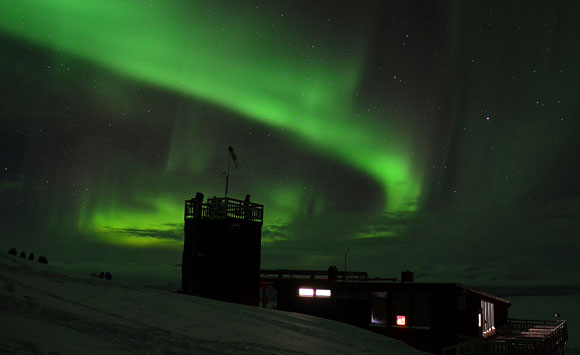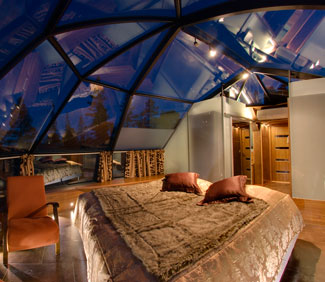By Madeline Greenhalgh

The northern lights light up the sky.cc
It’s the blackest of nights in the high latitudes, and the air is crisp with winter chill. Indigenous inhabitants of the ancient world observe the clear night sky when suddenly the stretch of black above their heads comes alight with color. Ribbons of green, red, and blue ripple across the sky, filling the onlookers with a mixture of awe, delight, and, in some cultures, fear. Though the common term for the phenomenon hadn’t yet been created, what the bystanders were observing was aurora borealis, or the northern lights.
A lack of modern technology in ancient times made finding a scientific explanation for the northern lights impossible. But that isn’t to say that ancient viewers of the event had no means to interpret or explain the vibrant colors lighting up the night sky. Their explanations ranged from the Makah Indians’ belief that the colors were fires lit by dwarves to the Sami legend that a fox running through the mountains slapped his tail across the snow which then emit- ted sparks into the atmosphere.
But not all explanations were so lighthearted. The emergence of the northern lights kindled fear both in the Point Barrow Eskimos, who believed the northern lights were an evil that they had to defend them- selves from, and in the Amrimen Fox Indians, who interpreted the lights as the avenging souls of enemies they’d slain.
Modern science may be able to explain aurora borealis in a less mystical fashion—simply stated, the colors are visible due to the collision of charged ions with the atmosphere in high latitudes—but a scientific explanation for the phenomenon does nothing to diminish its captivating nature. People today are perhaps more fascinated than ever with the awe-inspiring event and travel great lengths to be able to claim the title of Witness to the Northern Lights. “It’s worth going to considerable effort to experience [the northern lights],” says Brian Casper, a regular observer of aurora borealis during the two years he lived in Iceland. “It really is what it looks like in the movies; it’s amazing. You look at it, and you can’t even really believe it’s happening above you because it’s not like anything you’ve ever seen before.”
And with greater ease of travel and mobility, the earth’s northernmost locations all battle to draw tourists seeking auroras to their viewing points. But before embarking on a trek across the globe, northern lights hunters can use a little inside knowledge about the phenomenon to maximize the experience.
What to Know
The fact that the lights can only be viewed at night can dampen the excitement of a northern lights-centered vacation. Luckily, many hotels in popular viewing areas offer northern lights wake up calls that spare tourists cold, sleepless nights waiting for lights that never appear. When the lights are spotted in the area, hotel employees phone and alert guests that nature’s greatest light show has appeared nearby.
Keep in mind that location matters. Ambient light around city locations can lessen the impact of viewing aurora borealis and viewers only see faint ribbons of light—if the lights are visible at all. Darker, remote locations provide contrast for vibrant streaks of color lighting up the night sky. Tour guides in high northern lights viewing areas can lead visitors to ideal places to witness aurora borealis.
When to Go
The northern lights are visible in the dark skies between the months of September and April, and traveling further north increases the likelihood of witnessing the phenomenon. Even the clearest night in northern latitudes does not guarantee that the lights will be visible, so handle any trips to witness the lights with patience. “Be prepared to spend a lot of time looking; you can’t be impatient,” warns Casper.
All years are not created equally when it comes to the overall likelihood of viewing the northern lights or their duration and intensity. Higher solar activity equates to more chances to view aurora borealis. When planning a trip, be sure to research the solar activity during the time period of the trip.
Where to Go
Any town, city, or country that sits within the auroral zone—an oval shaped band of land above the Arctic that is 3° to 6° wide in latitude—is a prime location for northern lights viewing. Popular destinations such as Finland, Iceland, Norway, northern Canada, and Alaska fall within this stretch of land, offering diverse experiences for seeing the northern lights. And because the northern lights are a nighttime-only event, selecting a location to view the lights should rest on more than viewing odds; also take daytime activities into consideration. The chosen location can shape the experience during both the night and day. Here are three prime locations to check out.
Abisko, Sweden
The most recent census of Abisko—a tiny village in Swedish Lapland—counted a whopping eighty-five residents. But the quaintness of this town shouldn’t deter northern lights hunters; despite its isolated location, Abisko is a proper winter wonderland that provides an exceptionally unique vantage point of aurora borealis.

The Abisko Sky Station’s extremely remote location makes it an ideal place to view the northern lights. imagea.org via Compfight cc
Nestled in the Kiruna Mountains, Abisko National Park is home to the Abisko Sky Station, a structure perched at the pinnacle of a mountain only reachable by chairlift. The Sky Station’s extremely remote location away from any ambient light means that the swirls and curtains of bright color splashed across the sky are more visible at this location than almost any other spot on earth. In addition to the light show of a lifetime, the Sky Station contains a café, a gift shop, and an exhibition that educates visitors about the northern lights. Abisko is a mecca for classic winter sports and activities. Visitors can give Nordic or Alpine skiing a go, and skiers who desire a twist on their favorite sport can try telemark skiing—a downhill skiing technique with cross-country skis. Also available are dogsled tours that allow riders to drink in the natural beauty of the Swedish landscape.
For tourists who want to venture outside of the national park, Abisko is a pick-up and drop-off location for tours of the nearby ICEHOTEL. A breathtaking structure of translucent glass, the ICEHOTEL boasts intricately carved and designed suites, a restaurant, and a gift shop.
Fairbanks, Alaska
Whether a visitor wants to view the northern lights solo or have some guidance, Fairbanks can offer a spectacular platform to witness auroras. This Alaskan city—home to the famed Yukon Quest sled dog race— offers a multitude of northern light viewing tours that also demonstrate the variety of activities the area has to offer.
Many Fairbanks aurora tours make a stop at Chena Hot Springs Resort. Tourists come from far and wide for the upscale luxuries it offers coupled with a prime aurora viewing location. By day, visitors soak in the hot springs, take a sled dog tour, or visit the Aurora Ice Museum—the largest year-round ice museum in the world. For a bird’s eye view of the Arctic, they take flightseeing tours over the Arctic Circle and land in native villages to get a true Alaskan experience.
Evenings not spent viewing the northern lights from the resort are spent away from Fairbanks in a remote lodge that is far from any ambient light. From this cozy location, guests can stay warm while viewing auroras through large windows. Fairbanks’s long winter nights increase the chance of seeing a spectacular, vibrant aurora show.
But visitors need not participate in a guided tour to enjoy a Fairbanks northern lights experience. All of the aforementioned daytime activities can be enjoyed at the leisure of the tourist. And while the cabin location is restricted to tour members, venturing out of the immediate city limits can provide the lone adventurer with a view of the lights that is just as wonderful.
Levi, Finland
The northern lights are visible in the dead of night during the coldest part of the year, and both of these qualities can make viewing the phenomenon uncomfortable. But imagine viewing aurora borealis from the comfort of a bed. Nestled into the scenic Finnish Lapland, Levi is the largest ski resort in Finland. Levi offers attractive accommodations for all aspects of a northern lights vacation. Perhaps most unique and appealing are the Golden-Crown Levi Igloos. Located at the peak of a fell, these lodges boast domed glass roofs positioned directly above the beds, allowing tourists to have a one-of-a-kind view of the lights. Though modeled after traditional ice dwellings, these igloos are anything but uncomfortable. They vary in size and can accommodate parties ranging from one to eight, but each igloo is warm and cozy.
While nights can be spent comfortably viewing aurora borealis in the sky above, days in Levi are jam-packed with every imaginable wintertime activity. Aside from slopes perfect for skiers of all skill levels, Levi and its surrounding areas have activities more suited to those who prefer to keep their feet on solid ground.
The Levi Husky Park gives visitors a glance into the past of Arctic travel. Upon entering the park, visitors are happily greeted by hundreds of dogs—the Siberian huskies and Japanese spitzes that call this place home are friendly and welcoming to all who visit. But these dogs aren’t just friendly—they’re whip smart. An informative video shows visitors what the life of a sled dog entails, and handlers are quick to tell unforgettable stories about the dogs’ lives.
A mere forty minutes from Levi is the spectacularly beautiful Snow Village. Open from December to early April, the Snow Village is an arctic adventure like no other. Every construction—from a hotel to a restaurant—is made purely of snow and ice, giving visitors a uniquely chilly visit.
The sheets of color that danced across the sky and mesmerized ancient inhabitants of the North haven’t lost their grandeur with the passing of time. “In the dark, cold nights when everything was dead, you’d have blossoming northern lights,” recalled Casper. “They would really capture your attention, and you forgot where you were going because you were so distracted.” In the black of the night, modern viewers of nature’s most enthralling light show join with those of ancient times in admiring the ribbons of light rippling in the sky above the arctic tundra.


I’m pretty sure “seeing the Northern Lights” in on most anyone’s bucket list, but it is high priority on mine. This article got me excited to fulfill my dream of seeing them. I think it is really important to remember that a trip so see the Northern Lights is not for the impatient.
I’m not a fan of the cold, but I’d brave it at least once to see the Northern Lights.
I’ve always kind of wanted to see the Northern Lights, but I didn’t realize that there were so many locations that it was possible. This article made me really want to plan a trip to go see them sometime.
Especially with all of these cool pictures. Trip to Alaska, anyone?
Reading this article was really nostalgic for me! I’m from Alaska, and I remember staying up late in the wintertime just to see the lights. One time I even was lying out in the snow with my friends in a snow suit. These pictures are stunning, but when you see it in real life it’s like magic!
Looks like I may need to take a trip to Alaska! I also love the igloos in Finland. It would be amazing to see the lights through one of those igloos!
I think it’s interesting how other cultures interpreted the lights. I’ve always thought of them as a beautiful miracle of nature, but they viewed it as the vengeful souls of their enemies. A completely different perspective!